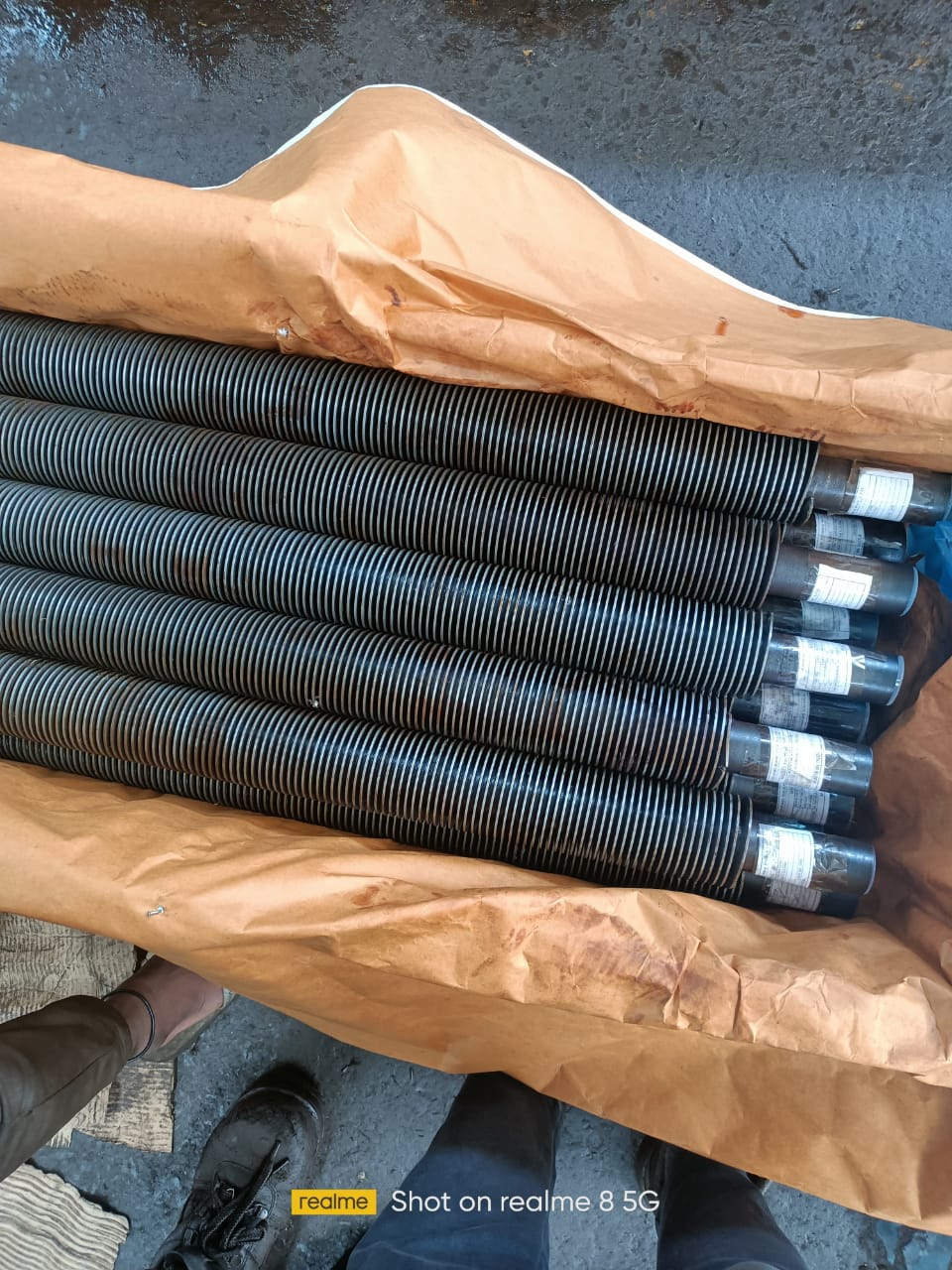Quick Inquiry
Solid-finned tubes are a crucial component of various industrial applications, including heat exchangers, boilers, and other thermal systems. As a reputed finned tube manufacturer in India, we understand the importance of maintaining these tubes to ensure optimal efficiency and durability of your equipment. In this comprehensive guide, we share our expertise to help you explore essential maintenance practices that business operators should implement to keep their solid-finned tubes in top working condition.

Maintenance Tips for Solid-Finned Tubes
1. Regular Inspection
Regular inspections form the foundation of a robust maintenance routine for solid-finned tubes. These assessments should thoroughly examine both the finned and seamless sections of the tubes. Look for any signs of corrosion, erosion, or physical damage that could compromise the structural integrity of the tubes. Identifying potential issues allows timely intervention and prevents minor concerns from escalating into major problems.
2. Routine Cleaning
Effective cleaning is pivotal in maintaining the efficiency of solid-finned tubes. Over time, these tubes can accumulate dust, dirt, and other contaminants, forming a layer that hinders the efficient transfer of heat. Regular cleaning using appropriate tools and techniques is essential. However, operators should exercise caution and choose cleaning methods that are gentle enough to avoid causing damage to the fins or the tube itself.
3. Chemical Cleaning
In addition to routine cleaning, periodic chemical cleaning is a valuable practice to incorporate into your maintenance schedule. It helps eliminate stubborn deposits and scales that may resist traditional cleaning methods. It is crucial to choose chemical solutions that are compatible with the materials of the finned tubes to prevent corrosion or any other adverse reactions. This process contributes to the tubes’ cleanliness and ensures consistent performance over time.
4. Inspect Fins
The fins of solid-finned tubes play a critical role in enhancing heat transfer efficiency. Regular inspections should focus on identifying any signs of damage, bending, or corrosion in the fins. Bent fins can significantly reduce the overall efficiency of the heat exchanger, leading to decreased performance. Addressing such issues promptly by straightening or replacing damaged fins is crucial to maintaining the tubes’ optimal functionality.
Furthermore, inspecting fins involves checking for any signs of fouling. Accumulation of dirt, grease, or other substances on the fin surfaces can impede heat transfer. Cleaning these fouled fins during regular inspections ensures that the tubes continue to operate at peak efficiency.
5. Tighten Connections
Loose connections within the finned tube system can lead to inefficiencies and potential leaks. Periodic checks and tightening all connections are essential to a thorough maintenance routine. This includes examining tube-to-tube sheet joints, tube support plates, and any other connections within the system. Ensuring all connections are tightened according to the manufacturer’s specifications minimises the risk of leaks and maintains the overall structural integrity of the tubes.
6. Check for Leakage
Leakage can be detrimental to the performance of solid-finned tubes, potentially resulting in system failures. Regular inspections should include a meticulous check for any signs of leakage, focusing on joints, welds, and tube ends. Detecting and addressing leaks promptly is crucial to preventing further damage and maintaining the reliability of the tube system.
Additionally, conducting pressure tests during inspections can help identify potential weak points in the system that may lead to leaks. This proactive approach allows for preemptive measures to be taken before leaks occur.
7. Inspect Fans and Motors
For finned tube systems utilising fans and motors for heat exchange and including them in the maintenance routine is paramount. Regular inspections should thoroughly examine fan blades, bearings, and motors. Lubricating moving parts per the manufacturer’s recommendations ensures smooth operation and prevents unnecessary wear and tear, contributing to the longevity of these critical components.
Moreover, checking the alignment of the fan blades is essential. Misalignment can lead to uneven wear and decreased efficiency. Addressing alignment issues during inspections ensures that the fans operate optimally, enhancing the overall performance of the solid-finned tube system.
8. Monitoring and Data Logging
Implementing a robust monitoring system is a proactive approach to finned tube maintenance. Utilise sensors and data logging equipment to continuously monitor critical parameters such as temperature, pressure, and flow rates. Analysing this data allows operators to identify trends, anticipate potential issues, and schedule maintenance activities accordingly.
Furthermore, incorporating predictive maintenance techniques, such as vibration analysis and thermography, can provide valuable insights into the health of the finned tubes. Early detection of abnormalities allows for timely interventions, preventing unplanned downtime and extending the lifespan of the equipment.
9. Record-Keeping
Maintaining comprehensive records of all maintenance activities is invaluable for solid-finned tube systems. A detailed log of inspections, cleanings, repairs, and modifications provides a historical perspective on the performance of the tubes. This record serves as a valuable resource for troubleshooting, allowing operators to trace the evolution of issues and implement effective solutions.
Additionally, detailed records assist in complying with regulatory requirements and industry standards. Having a well-documented maintenance history enhances transparency and accountability, crucial elements in ensuring the safe and reliable operation of the tubes.
Troubleshooting Solid-Finned Tubes
1. Reduced Heat Transfer
Reduced heat transfer efficiency is a common issue that operators may encounter with solid-finned tubes. This can result from accumulating deposits on the tube surfaces, hindering heat transfer between the fluid and the tube. As mentioned in the maintenance tips, regular cleaning is crucial to prevent this problem. Additionally, inspecting the fins for damage or deformation is essential. Bent fins reduce the effective surface area for heat exchange, diminishing overall efficiency. Straightening or replacing damaged fins during routine maintenance can address this issue and restore optimal heat transfer capabilities.
2. Uneven Temperature Distribution
Uneven temperature distribution across the finned tubes can indicate fluid flow issues or system blockages. Regular monitoring of temperature differentials along the length of the tubes can help identify potential problem areas. Cleaning the tubes to remove accumulated debris, ensuring proper fluid flow, and addressing any obstructions or irregularities in the system can rectify uneven temperature distribution. Periodic adjustments and maintenance will help maintain uniform heat transfer across the solid-finned tubes.
3. Vibration and Noise
Excessive vibration and noise indicate potential mechanical issues within the solid-finned tube system. This can result from misaligned fan blades, worn-out bearings, or imbalances in the rotating components. Routine inspections, including checks on fan blades, bearings, and motors, can help identify and rectify these issues. Proper lubrication and timely replacement of worn-out components are essential maintenance practices to prevent excessive vibration and noise, ensuring smooth operation and extending the lifespan of the equipment.
4. Corrosion
Corrosion poses a significant threat to the structural integrity of the finned tubes. It can lead to leaks, reduced heat transfer efficiency, and, ultimately, system failure. Regular inspections, including a thorough examination of the tubes for signs of corrosion, are essential. Implementing preventive measures such as chemical cleaning and using corrosion-resistant materials during manufacturing can mitigate the risk of corrosion. Prompt repairs and protective coatings can address any identified corrosion issues and extend the overall lifespan of the solid-finned tubes.
5. Reduced Airflow: In HVAC Applications
In HVAC applications, reduced airflow through the tubes can impact the system’s efficiency. This can result from clogged filters, debris accumulation, or issues with the fan. Regularly inspect and clean filters, ensuring unobstructed airflow. Additionally, include the inspection of fan blades, motors, and ducts in your maintenance routine. Proper cleaning and maintenance will enhance the airflow, contributing to the efficient operation of the HVAC system.
6. Inadequate Cooling/Heating
Inadequate cooling or heating is a symptom that can arise from various issues within the solid-finned tube system. It could be linked to reduced heat transfer efficiency, insufficient fluid flow, or malfunctioning components. Regularly monitor and record temperature differentials, ensuring they align with the system’s specifications. Addressing issues related to heat transfer, fluid flow, and other potential causes during routine maintenance will help maintain the desired cooling or heating performance level.
7. Temperature Differential
Monitoring temperature differentials across the finned tubes is a crucial aspect of troubleshooting. Deviations from the expected differentials can signal issues such as fouling, reduced heat transfer efficiency, or fluid flow problems. Regular data logging, as recommended in the maintenance tips, allows operators to proactively identify and address these issues. Troubleshooting temperature differentials involves comprehensively examining the entire system, including the tubes, fins, and fluid flow pathways.
Refer to Your Solid Finned Tube Manufacturer’s Documentation
Always refer to the manufacturer’s documentation for guidance when faced with troubleshooting challenges. Manufacturer specifications, recommended maintenance practices, and troubleshooting procedures are valuable resources for operators. Following the guidelines provided by them ensures that maintenance and troubleshooting efforts align with the intended design and specifications of the solid-finned tubes.
Consult Us for Expert Recommendations on Solid Finned Tubes
Elevate your industrial performance by consulting us for expert recommendations on seamless and finned tubes. As one of the top finned tube manufacturers, Anand Seamless Ltd is dedicated to providing cutting-edge solutions tailored to your unique requirements. Whether you operate in the USA, Spain, UK, Dubai, Germany, Italy, Kuwait, Oman, or Qatar, our export expertise extends to serve your global needs. Our seasoned professionals bring a wealth of knowledge in tube manufacturing, ensuring you receive top-notch recommendations and services for optimal efficiency and longevity.
From selecting suitable materials to troubleshooting issues, we’ve got you covered. Partner with us to enhance heat transfer capabilities and streamline your operations. Call us at +91-9099996851 to consult one of our experts or send your queries to inquiry@anandseamless.com.
lATEST BLOG |
|
How to Select the Right SA 179 Seamless Tube For Your Project?
Choosing the right SA 179 seamless tube for your p |
|
An Introductory Guide to Understanding Evaporator Tubes
Evaporator tubes are crucial components in various |
|
Guide to Maintaining Steam Coil Heater Tubes in HVAC Systems
Steam coil heater tubes are integral to the effici |
|
Carbon Steel Tubes: Essential Components in Shipbuilding
Selecting the right materials is of utmost importa |
|
How to Choose Right Grade Carbon Steel Seamless Tubes
Carbon steel seamless tubes are essential componen |

